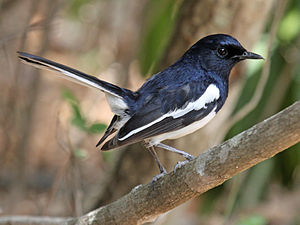Madagascar eel
| Madagascar eel | ||||||||||||
|---|---|---|---|---|---|---|---|---|---|---|---|---|

Madagascar eel ( Copsychus albospecularis ), male |
||||||||||||
| Systematics | ||||||||||||
|
||||||||||||
| Scientific name | ||||||||||||
| Copsychus albospecularis | ||||||||||||
| ( Eydoux & Gervais , 1836) |
The Madagaskardajal ( Copsychus albospecularis ) is endemic to Madagascar occurring bird from the family of flycatchers (Muscicapidae).
features
Madagascard eels reach a body length of 18 centimeters and a weight of 21 to 24 grams. There is a clear sexual dimorphism between the sexes . The males are predominantly colored glossy black. Only a narrow stripe on the wings, the lower control feathers and sometimes the belly area are white. With a similar pattern, the females show a matt, dark gray to brown in the areas that are black in the male.
voice
The singing consists of a series of clear, high notes and trills, which are performed calmly. The birds are able to imitate the singing of other species .
Similar species
The Seychelles eel ( Copsychus Sechellarum ) is very similar in drawing to the Madagascar eel . Since this species is endemic to the Seychelles , there is no geographical overlap with Copsychus s albospecularis .
Distribution, subspecies and habitat
The distribution area of the Madagascard eel includes the entire island of Madagascar. They occur there in a wide variety of biotopes and are native to dry coastal areas, rain and mangrove forests, as well as banana, cocoa or coffee plantations and gardens. The altitude distribution extends up to 1800 meters. In addition to the nominate form Copsychus albospecularis albospecularis , which occurs in northeast Madagascar , two other subspecies are known:
- Copsychus albospecularis inexspectatus Richmond , 1897 - in the center and southeast of Madagascar
- Copsychus albospecularis pica pelts , 1858 - in the west, south-west and north of Madagascar.
Way of life
The birds feed primarily on various insects , for example ants , beetles , grasshoppers and caterpillars, as well as spiders , lobsters and worms , which are preferably picked up from the ground. Sometimes vertebrates are also preyed on, for example small geckos or frogs . Berries are only occasionally used as food. The main breeding season falls from September to December. Individual nests were also found in February or until June. The cup-shaped nest is made of grass, leaf stalks, moss and animal hair and placed in earth walls, in tree hollows behind hanging vegetation or in banana trees and equipped with two to five blue-green and slightly gray-purple speckled eggs. The breeding and nestling period is 13 days each. After leaving, the boys are looked after by their parents for a few days. The birds sometimes suffer losses because they are a popular hunting object of the Madagascar sparrow ( Accipiter madagascariensis ).
Danger
The Madagascar eel is widespread and not uncommon in Madagascar. It is therefore classified by the World Conservation Organization IUCN as ![]() “ least concern = not endangered”.
“ least concern = not endangered”.
Individual evidence
- ↑ a b c d e N. Collar (2017). Madagascar Magpie-robin (Copsychus albospecularis). In: J. del Hoyo, A. Elliott, J. Sargatal, DA Christie & E. de Juana (eds.). Handbook of the Birds of the World Alive. Lynx Edicions, Barcelona. (accessed at http://www.hbw.com/node/58484 on March 19, 2017).
- ↑ occurrence
- ^ IOC Word Bird List
- ^ IUCN Red List
literature
- Josep del Hoyo , Andrew Elliott, David A. Christie: Handbook of the Birds of the World, Old World Flycatchers to Old World Warblers. Volume 11, Lynx Edicions, 2006, ISBN 978-84-96553-06-4 .
Web links
- Madagascar eel (Copsychus albospecularis) in the Encyclopedia of Life . Retrieved August 11, 2017.

